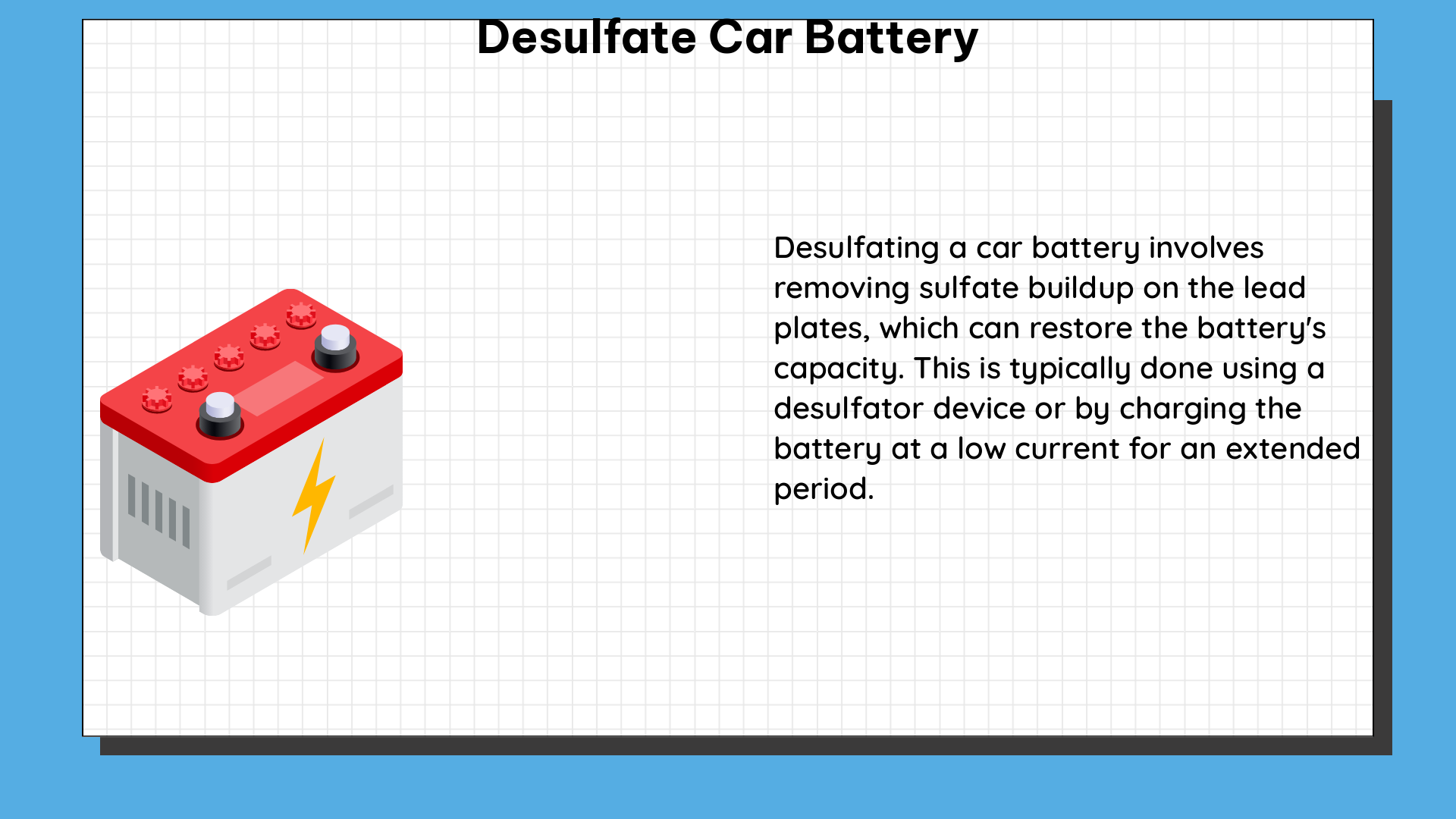Desulfating a car battery is a crucial process that can help restore the battery’s performance and extend its lifespan. This comprehensive guide will delve into the technical details of the desulfation process, providing you with a step-by-step manual to effectively desulfate your car battery.
Understanding Sulfation in Car Batteries
Lead-acid car batteries are susceptible to a phenomenon known as sulfation, where lead sulfate crystals accumulate on the battery’s lead plates. This buildup can reduce the battery’s capacity, increase its internal resistance, and ultimately lead to premature failure.
Sulfation can occur due to various factors, including:
– Undercharging the battery
– Leaving the battery in a discharged state for an extended period
– Exposure to high temperatures
– Overcharging the battery
The type of sulfation can be either reversible or permanent. Reversible sulfation can be addressed through desulfation, while permanent sulfation may require the replacement of the battery.
Desulfation Techniques

There are several methods to desulfate a car battery, each with its own advantages and considerations. Let’s explore the most common techniques:
Chemical Desulfation
One of the most popular methods is the use of chemical additives, such as Epsom salt (magnesium sulfate), to the battery’s electrolyte. These additives help dissolve the lead sulfate crystals and improve the battery’s overall performance.
To chemically desulfate a car battery:
1. Ensure the battery is fully charged before starting the process.
2. Measure the specific gravity of the electrolyte using a hydrometer. The specific gravity should be between 1.250 and 1.280.
3. Add Epsom salt to the electrolyte at a ratio of 1 tablespoon per gallon of electrolyte.
4. Charge the battery at a high voltage (14.5-14.6V) for an extended period, typically 12-24 hours, to help break down the lead sulfate crystals.
5. Monitor the battery’s voltage and specific gravity during the charging process. The specific gravity should increase as the sulfation is removed.
6. Once the desulfation is complete, adjust the electrolyte level if necessary and clean the battery terminals.
High Voltage Pulse Desulfation
Another method is the use of high voltage pulses to break down the lead sulfate crystals. This can be achieved with the help of a specialized desulfator device or a power supply that can deliver the required voltage and current.
To perform high voltage pulse desulfation:
1. Disconnect the battery from the vehicle and ensure it is fully charged.
2. Connect the desulfator device or power supply to the battery terminals, ensuring proper polarity.
3. Set the voltage to 15.5-16.5V and the current to a maximum of 5A.
4. Apply the high voltage pulses for 15-30 minutes, monitoring the battery’s temperature to prevent overheating.
5. Repeat the process until the battery’s voltage and specific gravity have stabilized.
6. Disconnect the desulfator device or power supply and reconnect the battery to the vehicle.
Overcharging Desulfation
In some cases, overcharging the battery at a controlled rate can also help remove the lead sulfate crystals. This method should be used with caution, as excessive overcharging can damage the battery.
To overcharge a car battery for desulfation:
1. Ensure the battery is fully charged before starting the process.
2. Connect the battery to a charger or power supply that can deliver a higher-than-normal charging voltage (14.5-14.6V).
3. Monitor the battery’s temperature and voltage closely during the overcharging process, which can take several hours.
4. Stop the overcharging process once the battery’s voltage and specific gravity have stabilized.
5. Disconnect the charger or power supply and reconnect the battery to the vehicle.
Monitoring and Maintenance
Regardless of the desulfation method used, it is crucial to monitor the battery’s performance and maintain it properly to prevent future sulfation.
Voltage and Specific Gravity Monitoring
- Check the battery’s voltage regularly, both when the vehicle is running and when it’s turned off. A fully charged battery should have a voltage of 12.6V or higher.
- Use a hydrometer to measure the specific gravity of the electrolyte. The specific gravity should be between 1.250 and 1.280 for a fully charged battery.
Maintenance and Charging
- Follow the manufacturer’s recommendations for charging and maintaining the battery.
- Avoid leaving the battery in a discharged state for extended periods.
- Clean the battery terminals and connections regularly to ensure good electrical contact.
- Consider using a battery maintainer or trickle charger to keep the battery fully charged during periods of inactivity.
Conclusion
Desulfating a car battery is a valuable process that can help restore its performance and extend its lifespan. By understanding the causes of sulfation, the various desulfation techniques, and the importance of proper maintenance, you can effectively desulfate your car battery and keep it in optimal condition.
Remember, the success of the desulfation process depends on various factors, and it’s essential to follow the manufacturer’s guidelines and monitor the battery’s performance regularly. With the right approach, you can breathe new life into your car’s battery and enjoy reliable and efficient performance.
References:
- Battery University, “BU-805: Additives to Boost Flooded Lead Acid”, https://batteryuniversity.com/article/bu-805-additives-to-boost-flooded-lead-acid
- Battery University, “BU-804b: Sulfation and How to Prevent it”, https://batteryuniversity.com/article/bu-804b-sulfation-and-how-to-prevent-it
- Bob Is The Oil Guy, “Has anyone actually successfully desulfated a battery?”, https://bobistheoilguy.com/forums/threads/has-anyone-actually-successfully-desulfated-a-battery.308482/

The lambdageeks.com Core SME Team is a group of experienced subject matter experts from diverse scientific and technical fields including Physics, Chemistry, Technology,Electronics & Electrical Engineering, Automotive, Mechanical Engineering. Our team collaborates to create high-quality, well-researched articles on a wide range of science and technology topics for the lambdageeks.com website.
All Our Senior SME are having more than 7 Years of experience in the respective fields . They are either Working Industry Professionals or assocaited With different Universities. Refer Our Authors Page to get to know About our Core SMEs.